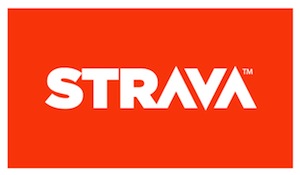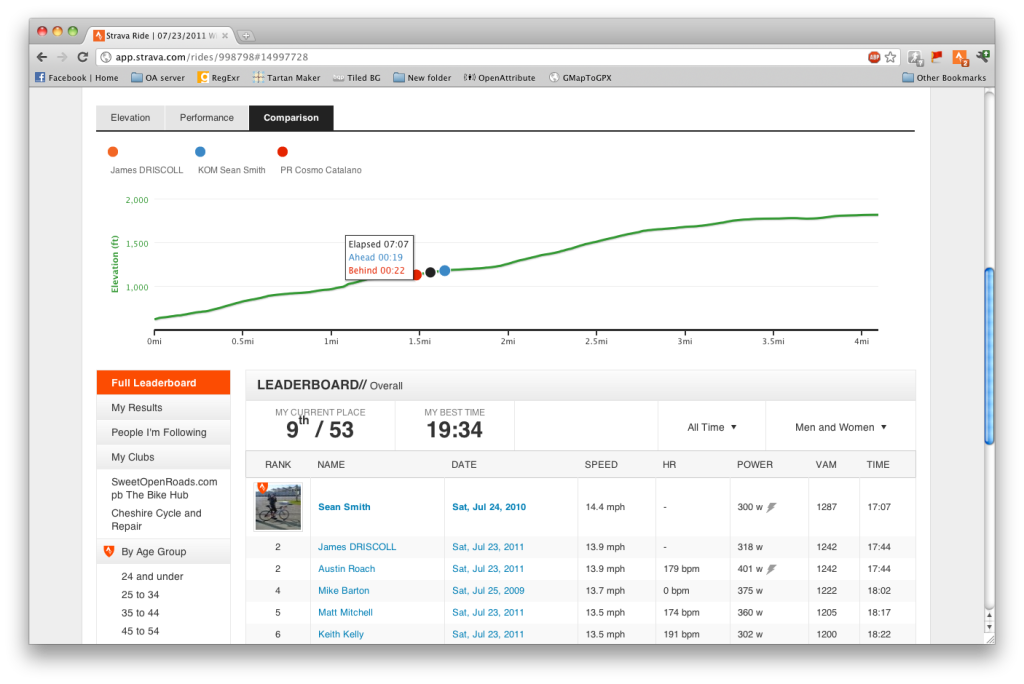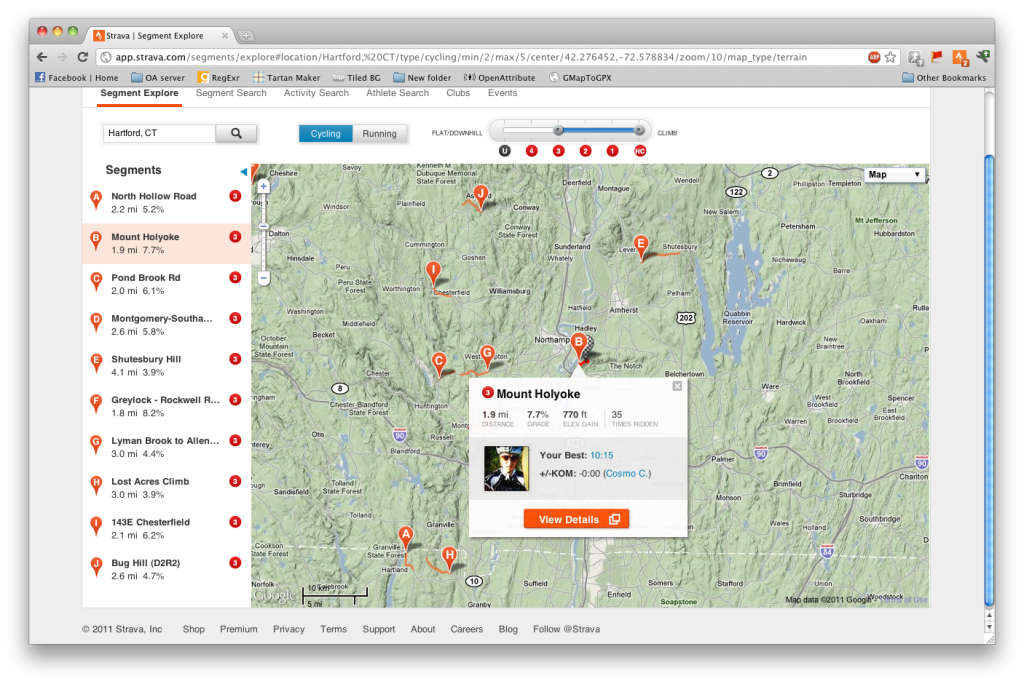 The luxury of data in cycling—or any sport, really—was once the rarified domain of the rich or professionally supported. Sure, we commoners had cyclocomputers and heart-rate monitors, but they generally only delivered data to a postage stamp screen, and had to be reset between rides.
The luxury of data in cycling—or any sport, really—was once the rarified domain of the rich or professionally supported. Sure, we commoners had cyclocomputers and heart-rate monitors, but they generally only delivered data to a postage stamp screen, and had to be reset between rides.
If you really felt like spending, you might get a blocky device with a usb cable and CD of poorly-written software (PC-only, of course) that turned your speed and HR into confusing looking graphs that you could compare against all your other confusing looking graphs from previous workouts, and not much else.
Thankfully, recent investor interest in social media, and the proliferation of GPS-enabled phones with reasonable amounts of processing power has resulted in a bloom of social fitness sites. The results aren’t universally good—my disdain for the unusable, boggy, UI carnage of MapMyHumanaRide is well documented—but generally speaking, the situation is a lot better than it was. And of all the options out there, I think Strava is the most thoughtfully crafted.
In the interests of full disclosure, I’ll note that back in 2010, Strava provided me a year of free membership and a Garmin 305 GPS unit to review their product. Lest you think I’ve been bought off, those of you who follow me on Twitter will note my repeated issues with the Edge 305 device, from broken buttons to fragile screens to DOA refurbs, and I currently pay full price for membership, and have been doing so since my trial offer expired.
As far as using the Strava site goes, your killer feature will depend on what you’re interested in as a rider. When I first began using it, the buzz was focused on a power-inferring algorithm, which made up watts for rides without power data, based on rider weight, speed, and road inclination. A cost-effective way of measuring power has long been a holy grail of the cycling world—remember the iBike?—but as intelligent readers probably knew going in, Strava isn’t going to take the place of a PowerTap or Quark anytime soon.
That said, while drafting, downhills, windspeed, and rolling resistance all play hell with Strava’s calculated wattage numbers, it does produce startlingly accurate results for any climb longer than a minute or so. Again, it’s not something you couldn’t do with your existing data, a well-crafted formula, and a calculator, but laid out alongside everything else, in a clean, smooth, web interface, you begin to think that this might be a feature worth paying for.
Indeed, data analysis and presentation is really Strava’s strength—and nowhere is this more evident than in its comparative data segmentation feature. Clocking historical times for a popular climb or TT is nothing new, but being able to spotlight, second-by-second, the moment where the truly talented make the difference is pretty darn cool. And if analyzing your own crushing defeats isn’t your thing, there are (if you pay) age group, club, and weight class filters, so almost anyone can find a combination of criteria under which they are King of the Mountain.
This sort of “competition without a number” at first struck me as self-aggrandizing and self-indulgent. But as it turns out, it’s a pretty useful training tool. Sure, KOMs might as often be determined by wind direction as wattage, but knowing you’re in an understood race against an army of online competitors is a great way to motivate for the extended agony of simulated race effort, and being able to compare efforts against yourself is fantastic training feedback. Maybe it’s just because my idea of a training log has historically consisted of remembering the previous day’s workout, but I found the total climb and mileage stats almost invaluable.
Of course, it’s not all completely rosy. For some time the segment and ride search tools have been pretty iffy—tracking down segments from a previous year’s race, for example, can be tricky. A lot of this is really a cataloging and indexing problem, since people will refer to races in a variety of different ways (Green Mountain, GMSR Stage 2, Green Mountain Stage Race, etc), but timestamps/geolocation should be enough to link the listings. In a similar vein, every long climb seems to contain 3 or 4 segments, reflecting various start and finish points. I’d be great if these could be grouped as subsections of one primary listing.
Still, the site is under near-constant development, and their recently added “Segment Explore” addresses many of the old issues, laying out all the segments by climb category in a given region via map view. The consistent, steady evolution of the site is very encouraging for future development, though I might gripe a bit that a good deal of the recent work seems to have been aimed at running-specific features. I understand the business logic, but I miss the good old days of “Strava is for Cyclists”.
Finally, and despite pouring some time into creating an API, Strava doesn’t play particularly nicely with others. Their API seems to be focused on allowing other applications to make changes within Strava, without necessarily freeing up any of the data it uses for cool new tools or external analysis. After much user bellyaching, they finally introduced a GPX export feature, but it’s pretty rudimentary, lacking many of the data sets collected by the site, and without the ability to export segments or your performances across them.
So in the interests of interoperability and data liberation, I’ve built two web tools to get your data off Strava the way you want it. One, the GPX Exporter, is not new, but remains the only way to export data for segments and efforts alone, or to get a GPX containing heartrate, cadence, or temperature. The other, a Strava to TCX export tool, ports everything—yes, including power—into Garmin’s bloated, mangled, propriety TCX format.
I didn’t build these tools just for users. As a product, Strava needs export, and probably a route creation feature. After all, what good is a great Explore tool to find a new routes and climbs if users need to handwrite cue sheets to get themselves out there? The fear, I suppose, is user exodus, but at the end of the day the data is cheap, and usability—which Strava has in spades—is the best guarantee of user retention.
This is why I pay for Strava, even though I (and all users) get the site’s most useful features for free. Don’t get me wrong—the things you get for a paid membership are very cool, but what I really want is continued development of data analysis tools with the same eye toward cleanliness and ease of use that the site currently has. And the five-dollar-a-month user fee seems a pretty fair investment to make for pushing things in that direction.


Good review.
I’ve also used Strava for quite a while.
As a rider, not a racer, the appeal is a little different. Since I’m not in races, measuring improvement is a little different. Most riders probably have routes they do repeatedly for training. It’s on specific segments of these routes when casual riders can see their improvement. There are several segments I’ve done 50+ times since using Strava, short 2 mile climbs, hill sprints, straight descents, etc. Seeing the improvement (or lack of) on these familiar segments helps teach me about the impact of different approaches (gearing, where to push into the red, etc.). Seeing that PR badge after a ride is a great motivator.
I also run, and use the new Strava running stuff. I appreciate their attempt, but it’s not that much different than Garmin Connect in this area. The heart rate analysis is helpful, but adding things like what shoes you run in, is a sign that there just isn’t a lot of room to improve on tracking running.
The club/team aspect is underutilized in Strava. There’s probably lots of interesting things that can be done in this area.
While I’m writing, thanks for the good web site. It’s a pleasure to read.
It’s probably worth noting that Power is only calculated for data that was taken from a device with a barometer. That means that phones and other basic GPS devices won’t allow users to get their power estimates from Strava. There is talk (as always) that Strava will one day add this but it’s yet to appear.
My biggest annoyance with Strava is that it excludes speed data for stationary trainer rides. Why would they go out of their way to deliberately exclude data? Your conspiracy theory is as good as mine.
I have to disagree with the comment about power calculation only being available for devices with a barometer (unless the iPhone has one). I use the free iPhone app, and power is calculated for my rides…
Nice review. I pay for my Strava membership, and thinks it is well worth the cost.
I also use strava and am generally happy with it. It was only recently, though, that they finally (finally!) made their graphs moderately acceptable. I’m willing to tolerate the dual y-axes for their particular purposes (although it still makes me cringe), but for the longest time their pace data would force an axis with limits all the way down to 0 min/mile or something, rather than sensibly drawing an axis that brackets the data.
And they also seem to have gotten a better handle on smoothing all that data, but it still needs a slider that lets the user adjust the amount of smoothing themselves.
Great review, and great comments.
I have to admit, I basically ignore the power data. I don’t ride with power (yet), and I’ve been assuming that whatever Strava is calculating is at the iBike level, and not really worth any serious analysis. Glad to hear that it’s calibrated reasonably well, at least for longer climbs.
For me, the most important factor is, as Michael describes above, the tracking of individual performance on segments over time, along with the virtual competition with others. This can turn just about any ride into a super-intense interval training session as you hit various segments, even on a routine bike path ride (and wouldn’t you know it, Cosmo happens to own the KOM on most of my local bike-path segments 🙂
Another aspect not explored in detail here is the social-networking component, with Strava functioning as a cycling-specific social networking app. I find it very interesting to see what types of rides other people in my area are doing, and to see who else is out there riding on routes that I ride all the time.
Great review. I am a paying member of Strava, and I learned some things from it. I agree with the previous comment by Jonathan, for me the best feature is easily the segments, a highly motivating tool. Also just seeing what types of rides others in my racing/riding community are doing. It really helps keep me going some days.
It’s seems Strava has hit a home run relating to tracking performance on ride segments. The club I ride with has always been into some serious hill climbing but the virtual competition aspect is driving many of them to chase after our local KOM spots. This feature alone is definitely inspiring a lot of additional training and effort.
Just used your GPX export service for Strava and loaded the course onto my Edge 800. It worked a treat and let me easily follow a training route that someone else had done. I was blown away with how easy this was and how perfect the end result was.
Great work – thanks for taking the time to create such a useful utility. This should be a one-click feature in Strava with direct copy across to your connected device (I assume that is possible as they can do a direct upload seamlessly).
Thank you a lot!!! I was looking long time for a way to export strava power estimation. Thanks again.